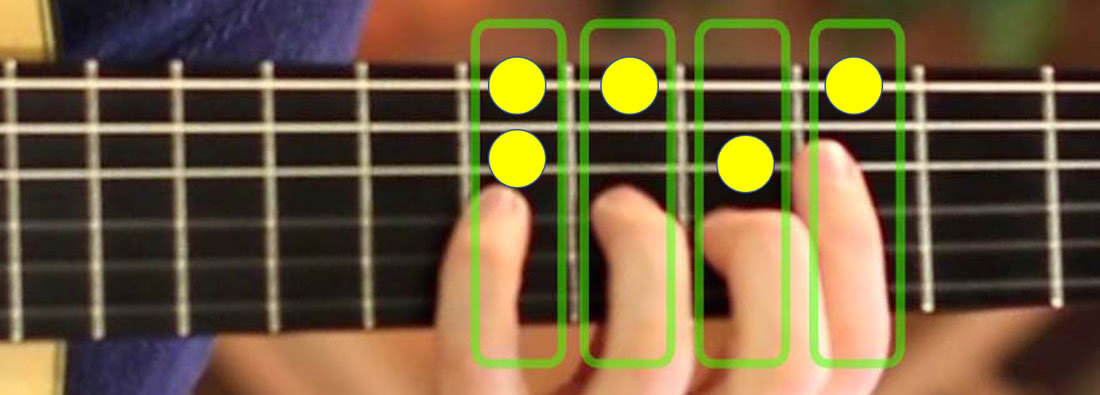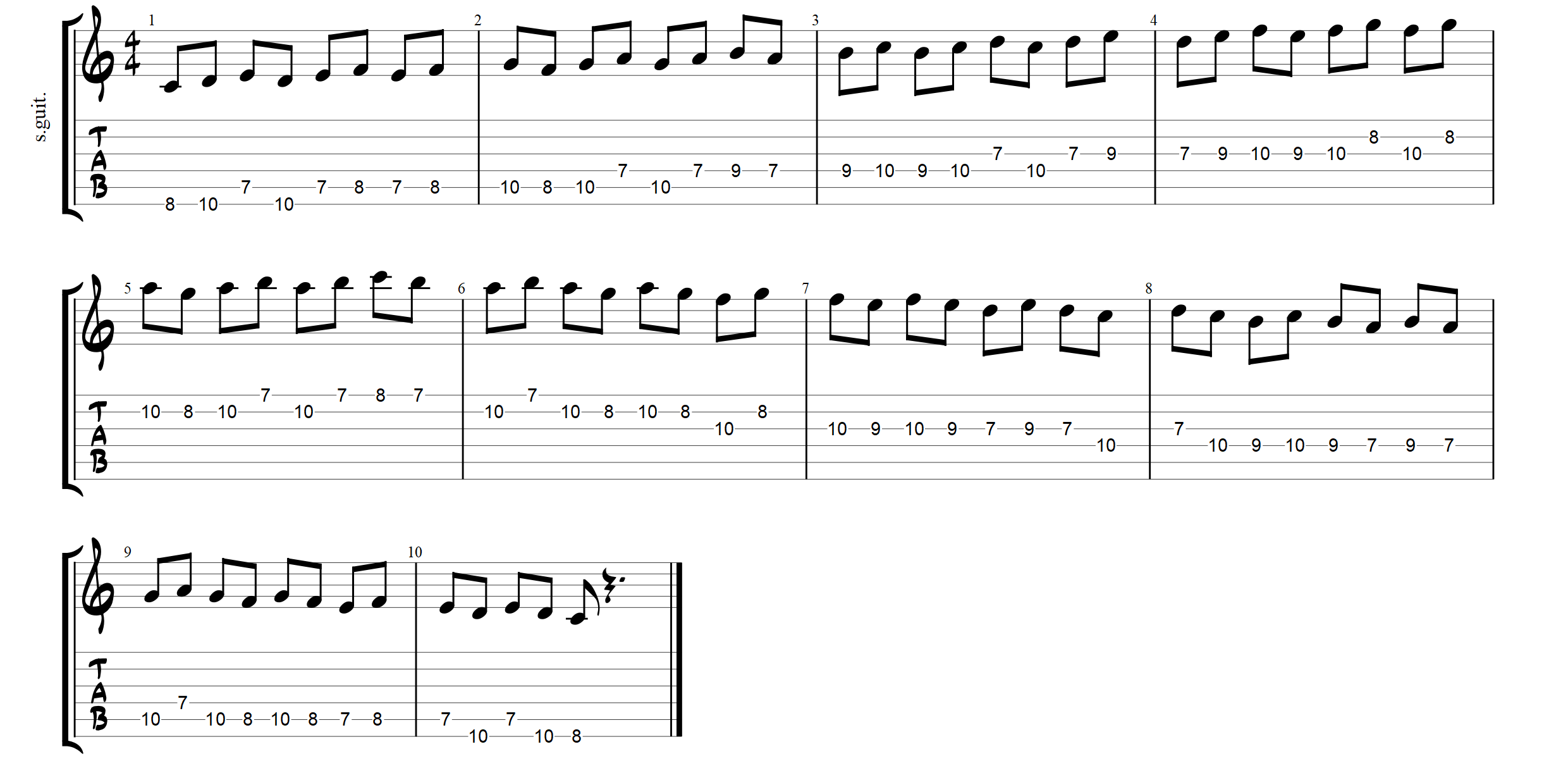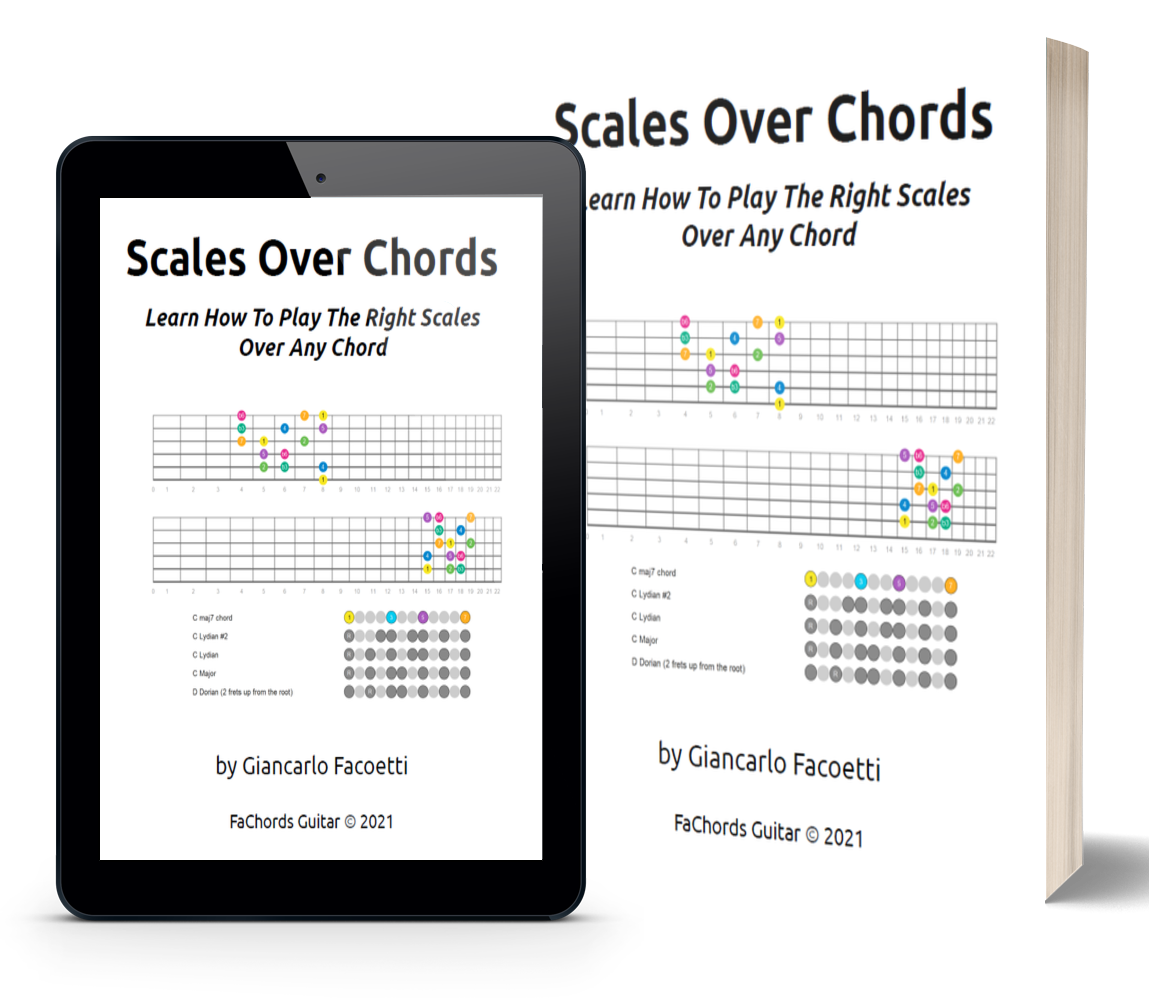Guitar Scales | The Complete Guide
Learn How To Play Scales Up and Down The Neck
This lesson will teach you everything you need to become a guitar scales master.
After learning strumming chords, the next most common step is to start playing single-note melodies, and knowing your scale patterns is helpful for this process. So let's get started!
Table of Content
What Is A Guitar Scale?
Scales are not the same as chords. When we practice scales we play them one note at a time, unlike a chord in which you play all the tones simultaneously.
We can consider a scale as a way to go from one note (say C) to the same note one octave upper (one octave is 12 frets on guitar)
Let's see this example on the guitar: take the C note at the 3rd fret of the A string , and the C one octave upper, at the 15th fret of the same string.

A scale is a way to go from one note to the same note one octave upper
If you count the number of the frets between the lower C and the higher C, you get 12. So this confirms that an octave spans 12 frets .
We have multiple ways to go from the lower C to the upper. We could play the frets 3, 5, 7, 8, 10, 12, 15, 15 or play only 3, 7, 9, 11, 15 or even play all the frets between the two C (that would be a chromatic scale)
Of course, this holds true for ascending and descending both (from the lower C to the upper and from the upper to the lower)
Basic Scale Theory
The relationship between each selected fret determines the scale structure and thus its name. We can create scales of all of the types. Probably you've already heard of major, minor, pentatonic, harmonic minor, whole-tone , augmented , lydian, dorian, to name a few; there is even a Neapolitan scale. Later in this article you'll find a table with all guitar scale.
Each scale type has its own unique combination of distances between the frets in the octave. This is called scale formula.
In music theory, frets translates to semitones, or half-steps. On guitar, it's safe to consider frets, semitones and half-steps the same measure.
Distances from the root are called intervals.
Usually, there are 7 notes to each scale within a one octave range, but not always: pentatonic scales have 5 notes, and there are even scales, like bebop scales, that have 8 notes!
Major scale steps

Major pentatonic scale steps

Considering that the scale doesn't change with an octave change we don't need to repeat it past 7 notes.
A C scale will always end and start on a C, and the same for each successive note. So a C major scale spanning 2 octaves is simply:
C D E F G A B C D E F G A B C
How To Read Guitar Scale Diagrams
Playing scales horizontally, on one single string, is a great way to visualize and understand the structures, but is impractical when it comes to making music, so usually, we use patterns that use all the strings.
Let's see how to read the scale diagrams that you'll find in this article. Have a look at the diagrams below, that shows you the C major scale

- The top line is always the first thinnest string (high E), and the bottom line is the sixth and thickest (low E).
- The diagrams show you the fretboard with the same point of view of a guitar player that is looking at the instrument.
- The colors of the note identify their degree (distance or intervals) from the root.
- The root is denoted in yellow.
- You must play one note at a time, it's not a chord!
Often, on the Internet, you'll find scale tabs. Tabs are of course far more popular than actually reading music because they use specific fret numbers of what to play.
Even better is if your fretboard diagrams or tabs come with finger placement instructions, as in exactly which fingering pattern is best while playing.
Remember: Scale Patterns are Movable!
Did you notice that the C major scale pattern above is just four frets wide? We call these box shapes, they span 4, 5 or 6 frets.
The reason why guitarists prefer to play scales along these box patterns are that the motion if more efficient: 1 finger for each fret (we're going to see this topic in the following)
The great thing about a guitar scales box is that it will work anywhere you place it on the guitar as long as you follow the pattern.
Each scale type has a specific box pattern which can be shifted to other keys. So, for example, if we want to play a D major scale , we move up the C scale pattern by two frets. Want an F major scale? Move the C pattern up by 5 frets!

To play the F major scale, we move the C major scale pattern five frets up, so that the root of the pattern (yellow note) is F
If you want to understand better how and why the frets are placed across the strings, have a look at the guitar notes tutorial .
The Most Common Used Guitar Scales
Here below you find some of the most used guitar scale.
Major Scale
The major scale is the foundation of Western Music so here it's the first in the list.

Major Pentatonic Scale
Pentatonic scales are composed of 5 notes (penta) and the Major pentatonic is a Major scale without the 4th and the 7th.

Minor Pentatonic Scale
The Minor pentatonic is another 5 notes scales.

Minor Pentatonic Scale (open strings)
If you play the minor pentatonic in the key of E, we have a particularly easy fingering because we can use open strings.

Blues Scale
The Blues scale is a Minor pentatonic with a flattened 5th added. It has a unique sound that you immediately recognize.

Minor Scale
The minor scale is another important scale to learn, and it's the relative to the major scale.

Dorian Scale
The Dorian scale is massively used in Jazz and Rock; it's a variation of the minor scale.

Mixolydian Scale
The Mixolydian scale is a Major scale with a flattened 7th, it has a Bluesy feeling.

Lydian Scale
The Lydian scale, thanks to its raised 4th, has an unique dreamy effect.

You find many more guitar scale diagrams in my complete ebook Scales Over Chords.
In the following video you find some other nice scale patterns:
How To Play Guitar Scales and Exercises
There are different ways to play scales on the guitar. Due to the nature of the fretboard, we have multiple options for going from one note to the upper octave.
We could use only one string, moving our fretting hand horizontally, our we could use all of the strings. There are 3 popular fingering types that you should know:
4 Frets Boxes
This is the common method for beginners when first learning to play scales. There are four frets for each finger, keeping your scale in a nice box already to play without much hand movement.
Each finger frets the notes on the nearest fret (for example, index finger on fret 1, middle finger on fret 2, ring on fret 3, and the pinky on fret 4)

3 Notes Per Strings
This is a way of playing scale often used by heavy metal shredders, and fast picking guitar players. Basically, your fingerings have exactly 3 notes per string: this is useful for high-speed alternate picking and legato.
The picking patterns are equal on all the strings (down, up, down, next string and repeat) and this allows very efficient motion .
When you play with legato , you pick only the first note on each string; again this is efficient.

C major scale 3 notes per string pattern
Horizontally, on 1 single string
Scales boxes and patterns are useful, but when you'll advance in your guitar studies you could feel yourself trapped in these fixed schemes.
Playing scales horizontally, on one single string, allows you to gain more fretboard navigation freedom .
Guitar Scales Exercises
Here below you find a great exercise that will help improve your scale speed and agility. It's based on the C major scale, I suggest to approach the pattern with the medium finger at the 8th fret.
For more things to practice, go to guitar scales exercises full list.

All Guitar Scales Chart
Here's a chart with the most used scales. Each link will take you to a new page that shows you several fretboard patterns for playing that scale.
P.s. All the charts show the scale with the note C as the root, you can move the patterns up and down the neck to play a scale with a different tonic.
If you wonder from where all these scales come from, you need to learn a bit about modes, a concept strictly related to scales, be sure to have a look at modes tutorial.
Guitar Scales Pdf Ebook
 Be sure to download the
Guitar Scales Patterns and Arpeggios Ebook
.
It's an handy reference pdf with tons of fretboard scale diagrams that you can print out.
Be sure to download the
Guitar Scales Patterns and Arpeggios Ebook
.
It's an handy reference pdf with tons of fretboard scale diagrams that you can print out.
You'll find the ebook in your free download area .
Common Scales
| Scale | Formula |
|---|---|
| Major Scale | 1 b2 2 b3 3 4 b5 5 #5 6 b7 7 |
| Minor Scale | 1 b2 2 b3 3 4 b5 5 b6 6 b7 7 |
| Major Pentatonic Scale | 1 b2 2 b3 3 4 b5 5 #5 6 b7 7 |
| Minor Pentatonic Scale | 1 b2 2 b3 3 4 b5 5 #5 6 b7 7 |
| Major Blues Scale | 1 b2 2 b3 3 4 b5 5 #5 6 b7 7 |
| Minor Blues Scale | 1 b2 2 b3 3 4 b5 5 #5 6 b7 7 |
Modes from the Major Scale
| Scale | Formula |
|---|---|
| Major Scale (Ionian) | 1 b2 2 b3 3 4 b5 5 #5 6 b7 7 |
| Dorian Scale | 1 b2 2 b3 3 4 b5 5 #5 6 b7 7 |
| Phrygian Scale | 1 b2 2 b3 3 4 b5 5 b6 6 b7 7 |
| Lydian Scale | 1 b2 2 b3 3 4 #4 5 #5 6 b7 7 |
| Mixolydian Scale | 1 b2 2 b3 3 4 b5 5 #5 6 b7 7 |
| Minor Scale (Aeolian) | 1 b2 2 b3 3 4 b5 5 b6 6 b7 7 |
| Locrian Scale | 1 b2 2 b3 3 4 b5 5 b6 6 b7 7 |
Modes From The Harmonic Minor Scale
| Scale | Formula |
|---|---|
| Harmonic Minor (Aeolian Maj 7) | 1 b2 2 b3 3 4 b5 5 b6 6 b7 7 |
| Locrian #6 Scale | 1 b2 2 b3 3 4 b5 5 #5 6 b7 7 |
| Ionian #5 Scale | 1 b2 2 b3 3 4 b5 5 #5 6 b7 7 |
| Dorian #4 Scale | 1 b2 2 b3 3 4 #4 5 #5 6 b7 7 |
| Phrygian Dominant Scale | 1 b2 2 b3 3 4 b5 5 b6 6 b7 7 |
| Lydian #2 Scale | 1 b2 2 b3 3 4 #4 5 #5 6 b7 7 |
| Super Locrian Bb7 Scale | 1 b2 2 b3 3 4 b5 5 b6 bb7 b7 7 |
Modes from The Melodic Minor Scale
| Scale | Formula |
|---|---|
| Melodic Minor Scale | 1 b2 2 b3 3 4 b5 5 #5 6 b7 7 |
| Dorian B2 Scale | 1 b2 2 b3 3 4 b5 5 #5 6 b7 7 |
| Lydian Augmented Scale | 1 b2 2 b3 3 4 #4 5 #5 6 b7 7 |
| Lydian Dominant Scale | 1 b2 2 b3 3 4 #4 5 #5 6 b7 7 |
| Mixolydian B6 Scale | 1 b2 2 b3 3 4 b5 5 b6 6 b7 7 |
| Aeolian B5 Scale | 1 b2 2 b3 3 4 b5 5 b6 6 b7 7 |
| Super Locrian Scale | 1 b2 2 b3 3 4 b5 5 b6 6 b7 7 |
Symmetrical And Diminished Scales
| Scale | Formula |
|---|---|
| Augmented Scale | 1 b2 2 b3 3 4 b5 5 #5 6 b7 7 |
| Whole-Tone Scale | 1 b2 2 b3 3 4 #4 5 #5 6 b7 7 |
| Whole-Half Scale | 1 b2 2 b3 3 4 b5 5 b6 6 b7 7 |
| Half-Whole Scale | 1 b2 2 b3 3 4 #4 5 #5 6 b7 7 |
Exotic Scales
| Scale | Formula |
|---|---|
| Indian Scale | 1 b2 2 b3 3 4 b5 5 b6 6 b7 7 |
| Japanese Scale | 1 b2 2 b3 3 4 b5 5 b6 6 b7 7 |
| Gipsy Hungarian Scale | 1 b2 2 b3 3 4 #4 5 b6 6 b7 7 |
| Neapolitan Scale | 1 b2 2 b3 3 4 b5 5 #5 6 b7 7 |
| Persian Scale | 1 b2 2 b3 3 4 b5 5 b6 6 b7 7 |
| Jewish Scale | 1 b2 2 b3 3 4 b5 5 b6 6 b7 7 |
| Bizantine Scale | 1 b2 2 b3 3 4 b5 5 b6 6 b7 7 |
| Arabic Scale | 1 b2 2 b3 3 4 #4 5 #5 6 b7 7 |
More Resources To Improve Your Guitar Scales Skills
Our introduction to guitar scales ends here. I'll leave you with some more resources to further deepen your music knowledge.
Complete Ebook: Scales Over Chords | Learn How To Play The Right Scales Over Any Chord

This ebook is all about guitar scales.
You'll find plenty of 1 and 2 octaves patterns over the entire fretboard.
The ebook also comes with a unique section in which you'll find which scales to play over any chord!
You'll get tons of new ideas for your solos and melodic lines!
Interactive Guitar Scales Finder
To further experiment with scales, fingerings, and keys, try our Guitar Scales Finder.
It's a free interactive tool that will help you learn you more than a hundred scales patterns. It's also available for left-handed guitar players , bass, ukulele and alternate tunings.
To stay updated on new tutorials, subscribe to the free newsletter (you'll also get access to the download area with many free printable resources)
